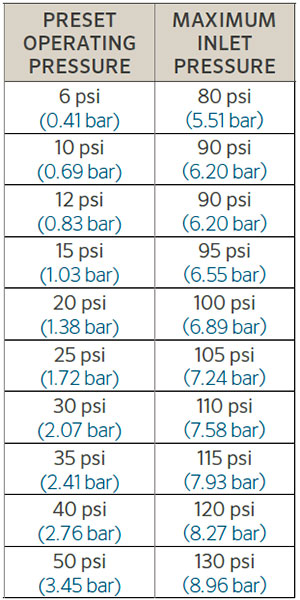Pressure regulators must always be installed downstream from all shut-off valves in the proper direction.
 Each model has a directional arrow on the side that shows the direction of the flow. This arrow should point downstream, toward the sprinklers and emitters.
Each model has a directional arrow on the side that shows the direction of the flow. This arrow should point downstream, toward the sprinklers and emitters.
Hydraulic friction loss is what makes a pressure regulator work. To compensate for friction inside the device, the recommendation is to assure inlet pressure is 5 psi (0.34 bar) higher than the regulator preset psi rating.
Each pressure regulator is designed with a maximum pressure rating, typically 80 psi (5.51 bar) above the designed pressure rating for that model. Operating outside these recommendations will affect the regulator’s performance and could cause premature failure.
Mechanized systems –
- Pressure regulators are usually installed immediately preceding the sprinkler.
- Some prefer to install the pressure regulator on the outlet or inlet side of the gooseneck. Increased pressure or head between the regulator and the sprinkler should be a design consideration.
Solid Set field installations –
- Regulators are usually installed at the beginning of the lateral.
- Although, based on the design, one regulator can be used to manage pressure for several laterals.
- Certain installations may require a pressure regulator for each sprinkler.
- In high flow scenarios, a high flow model should be used. Although, multiple regulators in manifold can be used to handle the specific flow requirements.
- Timer-control installations employ regulators after the control valve, whether for multiple units or inside a valve box.
Going in-depth into pressure regulator fundamentals
Check out the pressure regulator guide to learn more about the importance of maintaining correct system pressure to conserve water and energy, troubleshooting tips, and answers to FAQs.
Learn the fundamentals of pressure regulation with Senninger's free on-demand Pressure Regulation course on Hunter University. Learn how to install pressure regulators in different irrigation systems, select a model, identify wear issues, causes of pressure fluctuations and more.

